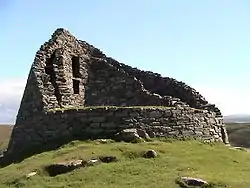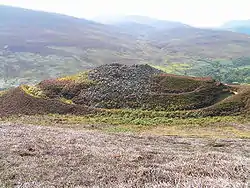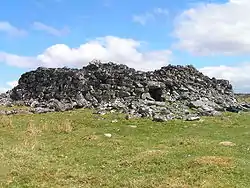Брох (Шотландия)
Брох — тип круглого крепостного сооружения железного века, выложенного методом сухой кладки (то есть без использования скрепляющего раствора). Брохи характерны только для Шотландии, где их существует более 100[1]. Слово broch происходит из древненорвежского языка и означает «крепость» (в английском языке существуют топонимы с тем же корнем, имеющим также форму brough, borough, borve)[2].




Некоторые брохи весьма сложны по архитектурному исполнению и относятся к типу «комплексных атлантических круглых домов» по классификации шотландских археологов, предложенной в 1980-е годы. Назначение брохов и их культурная принадлежность являются предметом споров. До 1960-х гг. ни у кого не вызывало сомнения, что брохи были созданы кельтами — предками шотландцев, мигрировавшими с материка[3][4]. Затем, ввиду археологических находок, вступавших в противоречие с данной теорией, всё больше археологов стали склоняться к версии об их пиктском или смешанном происхождении[5][6] (при этом не подлежит сомнению, что брохи могли использоваться и в послепиктский период).
Самые ранние брохи возникли около I века до н. э.[7][8]
Исходная высота брохов неизвестна; сохранившиеся до настоящего времени стены обычно имеют высоту лишь несколько метров, только шесть башен выше 6,5 метров, а рекорд сохранности принадлежит броху Моуса на Шетландских островах, высота стен которого составляет 13 метров. Предполагается, что брохи имели крыши, которые не сохранились до наших дней. Внутренний диаметр составлял от 5 до 15 метров. Некоторые были окружены небольшими жилыми зданиями.
См. также
Литература
- Armit, I. (1991) The Atlantic Scottish Iron Age: five levels of chronology, Proc. Soc. Antiq. Scot. v. 121, p. 181—214, ISSN 0081-1564
- Armit, I. (1996) The Archaeology of Skye and the Western Isles, Edinburgh University Press, ISBN 0-7486-0640-8
- Armit, I. (2003) Towers in the North: The Brochs of Scotland, Stroud : Tempus, ISBN 0-7524-1932-3
- Ballin Smith, B. and Banks, I. (eds) (2002) In the Shadow of the Brochs, the Iron Age in Scotland, Stroud : Tempus, ISBN 0-7524-2517-X
- Fojut, N. (1982) Towards a Geography of Shetland Brochs, Glasgow Archaeological Journal, v. 9, p. 38-59, ISSN 0305-8980
- Harding, D.W. (2000) The Hebridean Iron Age: Twenty Years’ Research, University of Edinburgh Department of Archaeology, Occasional Paper No. 20, ISSN: 0144-3313
- Harding, D.W. (2004) The Iron Age in Northern Britain, London : Routledge, ISBN 0-415-30150-5
- Hingley, R (1992) Society in Scotland from 700 BC to 200 AD, Proc. Soc. Antiq. Scot. v. 122, p. 7-53, ISSN 0081-1564.
- MacKie, E W 1992 The Iron Age semibrochs of Atlantic Scotland: a case study in the problems of deductive reasoning. Archaeol Journ 149 (1991), 149-81.
- MacKie, E W 1995a Gurness and Midhowe brochs in Orkney: some problems of misinterpretation. Archaeol Journ 151 (1994), 98-157.
- MacKie, E W 1995b The early Celts in Scotland. Miranda Green (ed) The Celtic World. Routledge, London: 654-70.
- MacKie, E W 1997 Dun Mor Vaul re-visited, J.N.G. Ritchie (ed) The Archaeology of Argyll. Edinburgh: 141-80.
- MacKie, E W 1998 Continuity over three thousand years of northern prehistory: the ‘tel’ at Howe, Orkney. Antiq Journ 78, 1-42.
- MacKie, E W 2000 The Scottish Atlantic Iron Age: indigenous and isolated or part of a wider European world? 99-116 in Jon C Henderson (ed) The Prehistory and Early History of Atlantic Europe. BAR International Series 861: Oxford.
- MacKie, E W 2002a Excavations at Dun Ardtreck, Skye, in 1964 and 1965. Proc Soc Antiq Scot 131 (2000), 301—411.
- MacKie, E W 2002b The Roundhouses, Brochs and Wheelhouses of Atlantic Scotland c. 700 BC — AD 500: architecture and material culture. Part 1 The Orkney and Shetland Isles. British Archaeological Reports British Series 342. Oxford.
- MacKie, E. W. 2005 119. Scottish brochs at the start of the new millennium, 11-31 in Turner, Val E, Nicholson, Rebecca A, Dockrill, S J & Bond, Julie M (eds.) Tall stories? Two millennia of brochs. Lerwick.
Примечания
- Armit (2003) p. 16.
- Armit (2003) p. 13.
- Scott, Sir Lindsay (1947), ‘The problem of the brochs’, Proceedings of the Prehistoric Society 13, pages 1-36.
- Childe, V. G. (1935) The Prehistory of Scotland. London.
- Parker Pearson, M. & Sharples, N. et al (1999) Between land and sea: excavations at Dun Vulan, South Uist. Sheffield.
- MacKie, E. W. (1965) 'The origin and development of the broch and wheelhouse building cultures of the Scottish Iron Age'. Proceedings of the Prehistoric Society 31, pages 93-146.
- MacKie, E. W. (2007) The Roundhouses, Brochs and Wheelhouses of Atlantic Scotland c. 700 BC — AD 500: architecture and material culture. Part 2 The Mainland and the Western Islands. British Archaeological Reports British Series (forthcoming). Oxford.
- For the C14 dates for the Shetland sites see Shetland Amenity Trust Архивировано 4 мая 2009 года. Retrieved 14 August 2007.